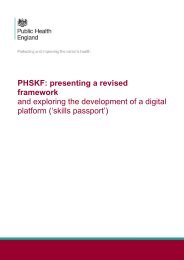Understanding patient flow in hospitals
understanding_patient_flow_in_hospitals_web_0
understanding_patient_flow_in_hospitals_web_0
You also want an ePaper? Increase the reach of your titles
YUMPU automatically turns print PDFs into web optimized ePapers that Google loves.
The aim that 95% of <strong>patient</strong>s attend<strong>in</strong>g A&E should be admitted,<br />
discharged or transferred with<strong>in</strong> four hours is one of the highest<br />
profile NHS targets, yet it is be<strong>in</strong>g consistently missed across<br />
England. Although the target can be over-emphasised, struggles<br />
<strong>in</strong> meet<strong>in</strong>g it are associated with deeper problems <strong>in</strong> the capacity<br />
to move <strong>patient</strong>s <strong>in</strong>to hospital wards. This brief<strong>in</strong>g draws on<br />
theories about congestion to look at why this has become more<br />
difficult <strong>in</strong> the hospital sett<strong>in</strong>g, and what can be done about<br />
it. It looks at ongo<strong>in</strong>g changes driv<strong>in</strong>g pressure on bed space,<br />
<strong>in</strong>clud<strong>in</strong>g mortality, the squeeze on bed space dur<strong>in</strong>g years of<br />
austerity, ris<strong>in</strong>g numbers of <strong>patient</strong>s with multiple conditions, and<br />
delayed discharges. It also looks at the solutions available short of<br />
actually build<strong>in</strong>g enough beds to restore free space, and suggests<br />
managers should focus <strong>in</strong> particular on the m<strong>in</strong>ority of longstay<strong>in</strong>g<br />
<strong>patient</strong>s who account for a majority of bed use. Given<br />
the variation dur<strong>in</strong>g the day, and with an <strong>in</strong>creas<strong>in</strong>g number of<br />
<strong>patient</strong>s leav<strong>in</strong>g <strong>in</strong> a matter of hours, it urges the NHS to <strong>in</strong>vest<br />
<strong>in</strong> IT and management systems that can track and deal with the<br />
need for beds and <strong>patient</strong> movement <strong>in</strong> real time.<br />
Acknowledgements<br />
This work has been <strong>in</strong>formed by many people who have worked with the authors<br />
and <strong>in</strong>formed their th<strong>in</strong>k<strong>in</strong>g. We thank Kate Silvester and Paul Walley for their ideas<br />
and contributions. We are grateful to Monitor (now NHS Improvement) and GE<br />
F<strong>in</strong>namore for sponsor<strong>in</strong>g sem<strong>in</strong>ars that contributed to our th<strong>in</strong>k<strong>in</strong>g, to Paul Smith for<br />
his analysis of Hospital Episode Statistics data, and to Andy Cowper and Mark Dayan<br />
for their significant editorial <strong>in</strong>put and guidance.<br />
Many of the themes that this report explored were triggered by conversations on the<br />
frontl<strong>in</strong>e of <strong>hospitals</strong> that the lead author has worked <strong>in</strong>. In particular, we thank Laura<br />
Allen, Bob Gregory, Paul Younge and Jude French for their valuable <strong>in</strong>sights, and Phil<br />
Mart<strong>in</strong> for extract<strong>in</strong>g the data that has illustrated them.<br />
This work was made possible as a result of North Bristol NHS Trust agree<strong>in</strong>g to<br />
Sasha Karakusevic’s secondment to the Nuffield Trust and cont<strong>in</strong>ued use of Dr Foster<br />
Intelligence tools.<br />
Hospital Episode Statistics data © 2016, re-used with the permission of the Health &<br />
Social Care Information Centre. All rights reserved.<br />
F<strong>in</strong>d out more onl<strong>in</strong>e at: www.nuffieldtrust.org.uk/publications



